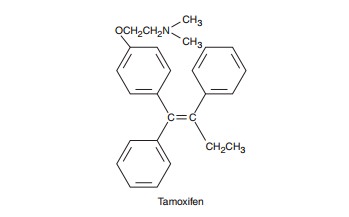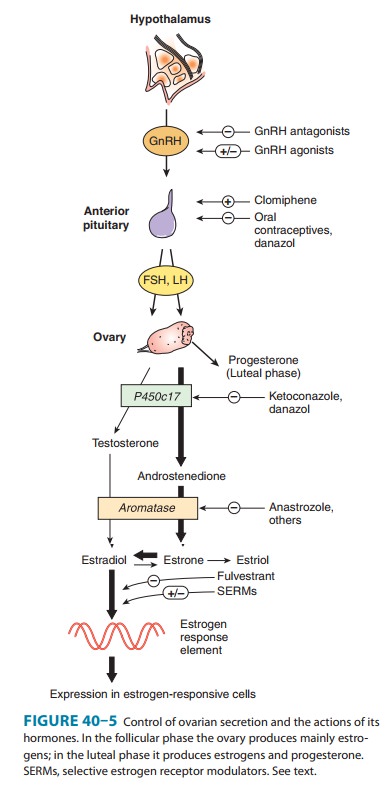Chapter: Basic & Clinical Pharmacology : The Gonadal Hormones & Inhibitors
Tamoxifen & Related Partial Agonist Estrogens
ESTROGEN & PROGESTERONE INHIBITORS & ANTAGONISTS
TAMOXIFEN & RELATED PARTIAL
AGONIST ESTROGENS
Tamoxifen, a
competitive partial agonist inhibitor of estradiol at the estrogen receptor (Figure
40–5), was the first selectiveestrogen
receptor modulator (SERM) to be introduced. It isextensively used in the
palliative treatment of breast cancer in postmenopausal women and is approved
for chemoprevention ofbreast cancer in high-risk women . It is a non-steroidal
agent (see structure below) that is given orally. Peak plasma levels are
reached in a few hours. Tamoxifen has an initial half-life of 7–14 hours in the
circulation and is predominantly excreted by the liver. It is used in doses of
10–20 mg twice daily. Hot flushes and nausea and vomiting occur in 25% of
patients, and many other minor adverse effects are observed. Studies of
patients treated with tamoxifen as adjuvant therapy for early breast cancer
have shown a 35% decrease in contralateral breast cancer. However, adjuvant
therapy extended beyond 5 years in patients with breast cancer has shown no
further improvement in outcome. Toremifene
is a structurally similar compound with very similarproperties,
indications, and toxicities.

Prevention of the
expected loss of lumbar spine bone density and plasma lipid changes consistent
with a reduction in the risk for atherosclerosis have also been reported in
tamoxifen-treated patients following spontaneous or surgical menopause.
However, this agonist activity also affects the uterus and may increase the
risk of endometrial cancer.
Raloxifene is another partial estrogen agonist-antagonist(SERM) at some but
not all target tissues. It has similar effects on lipids and bone but appears
not to stimulate the endometrium or breast. Although subject to a high
first-pass effect, raloxifene has a very large volume of distribution and a
long half-life (>24 hours), so it can be taken once a day. Raloxifene has
been approved in the USA for the prevention of postmenopausal osteoporosis and
pro-phylaxis of breast cancer in women with risk factors.
Clomiphene is an older partial agonist, a weak estrogen thatalso acts as a
competitive inhibitor of endogenous estrogens (Figure 40–5). It has found use
as an ovulation-inducing agent .

Related Topics